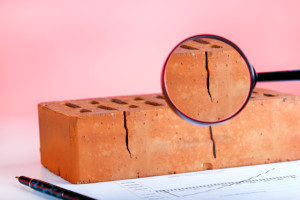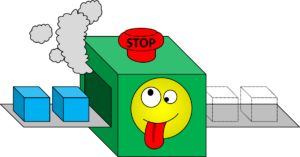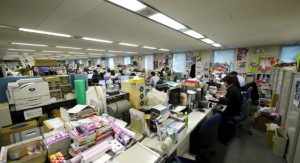 This post continues the series on the pillars of Total Productive Maintenance (TPM). Here we look at the last four pillars: quality, training, administrative, and safety. However, I find those pillars weaker than the first four. While the topics are important, in my view they should not be separate pillars. I think these topics are either better placed elsewhere (administrative) or should be integral part of all the other pillars (quality, training, and safety). Hence, I believe this is a weaker part of the TPM framework, and I won’t go into as much details as the previous pillars. In any case, let’s have a look. But feel free to disagree! I am looking forward to your comments, as I will surely learn something from them.
This post continues the series on the pillars of Total Productive Maintenance (TPM). Here we look at the last four pillars: quality, training, administrative, and safety. However, I find those pillars weaker than the first four. While the topics are important, in my view they should not be separate pillars. I think these topics are either better placed elsewhere (administrative) or should be integral part of all the other pillars (quality, training, and safety). Hence, I believe this is a weaker part of the TPM framework, and I won’t go into as much details as the previous pillars. In any case, let’s have a look. But feel free to disagree! I am looking forward to your comments, as I will surely learn something from them.
For a quick reference, here again are the eight pillars of TPM. The bold ones are the focus of this blog post.
- Focused Improvement (meaning Continuous Improvement)
- Autonomous Maintenance
- Planned Maintenance
- Early Equipment Management (meaning Design for Maintenance)
- Quality Maintenance (which in lean would be called Jidoka)
- Education and Training (which in lean would be part of standardization)
- Administrative & Office Maintenance
- Safety, Health, and Environment
Quality Maintenance
 Let’s have a look at Quality Maintenance. In Japanese this is called Hinshitzu Hozen (品質 保全 for quality and management). Quality is a very worthy goal in manufacturing. But is it an integral part of maintenance? The goal of quality maintenance in TPM is simple: zero defects. However, here I have two gripes right away. While zero defects sounds good, it may not always be the best solution. Getting to truly zero defects can be very expensive, and it may not even possible in all cases. You should push for quality if the impact of a defect is large. If a defect leads to a plane dropping out of the sky, you better make sure that there are no defects. However, in other cases a defect may not be anything of significance. If you buy a pack with 100 plastic forks, it doesn’t really matter if one is broken. Hence, push quality only within the limits of reason. I wrote a whole post on this gripe: Lean Is Zero Defects? – I Don’t Think So!
Let’s have a look at Quality Maintenance. In Japanese this is called Hinshitzu Hozen (品質 保全 for quality and management). Quality is a very worthy goal in manufacturing. But is it an integral part of maintenance? The goal of quality maintenance in TPM is simple: zero defects. However, here I have two gripes right away. While zero defects sounds good, it may not always be the best solution. Getting to truly zero defects can be very expensive, and it may not even possible in all cases. You should push for quality if the impact of a defect is large. If a defect leads to a plane dropping out of the sky, you better make sure that there are no defects. However, in other cases a defect may not be anything of significance. If you buy a pack with 100 plastic forks, it doesn’t really matter if one is broken. Hence, push quality only within the limits of reason. I wrote a whole post on this gripe: Lean Is Zero Defects? – I Don’t Think So!

My second gripe is: In my opinion, this topic is ill-placed under the framework of maintenance! There are much better frameworks out there, like Total Quality Management (TQM). Total Productive Maintenance is sometimes even confused with Total Quality Management, and even the abbreviations are similar (TPM vs. TQM). If you are in the lean framework, Jidoka or poka yoke would be a possible topic here, and machines should stop automatically if they detect an abnormality.
 TPM and quality is at least loosely related, as bad maintenance can lead to more defects, and preventive maintenance can prevent defects by preventing breakdowns. However, my goal in maintenance would be to get the machine into good shape, and the good shape should be good enough so that no defects happen. Reducing defects even further is a quality topic. This may lead to changes in maintenance, but for me the quality guys are in the lead here. In any case, the details of the TPM quality maintenance pillar could be found almost identically in a TQM handbook. Hence, the methods uses for quality management in TPM are sound, prevent defects through jidoka or similar tools, use statistical process control to notice trends before defect happen, and if a defect happens use root cause analysis to figure out how to prevent it from happening again, and so on. In sum, the topic is important, but I would see it as part of quality, not maintenance.
TPM and quality is at least loosely related, as bad maintenance can lead to more defects, and preventive maintenance can prevent defects by preventing breakdowns. However, my goal in maintenance would be to get the machine into good shape, and the good shape should be good enough so that no defects happen. Reducing defects even further is a quality topic. This may lead to changes in maintenance, but for me the quality guys are in the lead here. In any case, the details of the TPM quality maintenance pillar could be found almost identically in a TQM handbook. Hence, the methods uses for quality management in TPM are sound, prevent defects through jidoka or similar tools, use statistical process control to notice trends before defect happen, and if a defect happens use root cause analysis to figure out how to prevent it from happening again, and so on. In sum, the topic is important, but I would see it as part of quality, not maintenance.
Education and Training
 This pillar is about education and training, or Kyōiku Kunren (教育 訓練 for education; schooling; training; instruction; teaching; upbringing and training; drill; practice; discipline) in Japanese. Good maintenance requires skills. Especially autonomous maintenance needs training of the operators. Yet I am a bit perplexed that it is a separate pillar. Rather I would have this integrated into other pillars. I can’t do autonomous maintenance if I don’t do training of the operators. It is too tightly inter-meshed for a separate pillar. If anything, I would have it as a foundation of the TPM house.
This pillar is about education and training, or Kyōiku Kunren (教育 訓練 for education; schooling; training; instruction; teaching; upbringing and training; drill; practice; discipline) in Japanese. Good maintenance requires skills. Especially autonomous maintenance needs training of the operators. Yet I am a bit perplexed that it is a separate pillar. Rather I would have this integrated into other pillars. I can’t do autonomous maintenance if I don’t do training of the operators. It is too tightly inter-meshed for a separate pillar. If anything, I would have it as a foundation of the TPM house.
TPM incorporates good existing tools, like a skill matrix. It also aims to create a structure for the training, so as not to miss out any stakeholders in maintenance. In my view, however, I miss the mentioning of standards. Maybe I am too biased from lean, but a lot of training should be training in the use of a standard. Having a standard includes not only training of the operators, but also improving the standard.
Administrative & Office Maintenance
 The pillar of administrative and office maintenance is called Kanri kansetsu bumon katsudō (管理 間接部門活動 for control and internal division; back-office section; indirect department) in Japanese. The idea of the administrative and office maintenance pillar is also a bit fuzzy. Some sources see it as the administration supporting the maintenance efforts. Other sources see it as the reduction of waste in administrative areas. Both are valid topics, but again I think both are misplaced as a part of the maintenance efforts. To me it also does not justify to be a pillar. Besides, if we start about maintenance and efficiency in the office, why not have more pillars for logistics, healthcare, service, and so on. But again, this may be the effort to turn maintenance into an overarching framework for the entire industry.
The pillar of administrative and office maintenance is called Kanri kansetsu bumon katsudō (管理 間接部門活動 for control and internal division; back-office section; indirect department) in Japanese. The idea of the administrative and office maintenance pillar is also a bit fuzzy. Some sources see it as the administration supporting the maintenance efforts. Other sources see it as the reduction of waste in administrative areas. Both are valid topics, but again I think both are misplaced as a part of the maintenance efforts. To me it also does not justify to be a pillar. Besides, if we start about maintenance and efficiency in the office, why not have more pillars for logistics, healthcare, service, and so on. But again, this may be the effort to turn maintenance into an overarching framework for the entire industry.
Safety, Health, and Environment
 The last pillar of TPM is safety, health, and environment. In Japanese safety and health are merged, and it is called Anzen and Kankyō Kanri (安全 for safety; security, 環境 管理 for environment and control; management). These topics are very important, but here too I think these are misplaced. If you have a separate pillar for safety, it makes you vulnerable to neglect it elsewhere until you actually get to that column. I find it risky to have a separate deployment of your safety efforts.
The last pillar of TPM is safety, health, and environment. In Japanese safety and health are merged, and it is called Anzen and Kankyō Kanri (安全 for safety; security, 環境 管理 for environment and control; management). These topics are very important, but here too I think these are misplaced. If you have a separate pillar for safety, it makes you vulnerable to neglect it elsewhere until you actually get to that column. I find it risky to have a separate deployment of your safety efforts.
In any case, the goal is zero accidents, zero incidents, zero pollution, zero burnout, etc. The underlying ideas are also sensible, by alerting and teaching the workers on health and safety, by making machines safe to use (although this is again an overlap with the pillar early equipment management), having first-aid equipment and people that know how to use it, actively searching for safety and related issues so they can be fixed before someone gets hurt, and so on. But again, in my view this is not a separate column.
In any case, regardless where you have training, quality, or safety, you must have it somewhere. Now, go out, train your people to improve quality and safety, and organize your industry!
P.S.: Many thanks to Leandro Barreda and Gil Santos for nudging me to write about maintenance.
Series Overview
- A Brief History of Maintenance
- What Are the Goals of Maintenance?
- An Overview of the Eight Pillars of Total Productive Maintenance
- The Pillars of TPM – Focused Improvement
- The Pillars of TPM – Autonomous Maintenance
- The Pillars of TPM – Planned Maintenance
- The Pillars of TPM – Early Equipment Management
- The Pillars of TPM – Quality, Training, Administration, and Safety
- The Pillars of TPM – The Missing Pillar Reactive Maintenance?

Hi Christoph – congratulations on your new book. It sounds like a winner for sure! I agree that these pillars appear forced into the Maintenance house and are weak as stand alone pillars. Personally, I believe they belong in your 5S foundation area and the case can be made they are behaviors for doing your job every day – IMO.
Hi Charles, yes, they are odd pillars. IN one of my next posts I will show an alternative version of the pillars, which I believe are more organized.